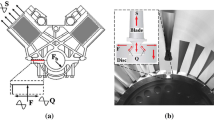Abstract
A fretting fatigue life estimation method that takes into account the stress gradient effect was developed by the authors [Journal of Mechanical Science and Technology, 28 (2014) 2153-2159]. In the developed method, fatigue damage value at the cracking location is corrected with fatigue damage gradient and the corrected value is compared directly with the plain fatigue data for life estimation. In other words, the correction factor is the ratio of plain fatigue damage to fretting fatigue damage at the same life and a function of fatigue damage gradient. Since reliability of the method was verified only for cylinder-on-flat contact configuration in the previous study, the present study extends application of the method to flat-on-flat contact configurations by developing the correction factor for both the contact configuration. Fretting fatigue experiments were conducted to obtain fatigue life data for various fretting pads. Finite element analyses were conducted to evaluate the Smith-Watson-Topper (SWT) fatigue damage parameter in the cracking region. It is revealed that the SWT parameter in fat-on-flat contact configuration decreases exponentially away from the surface as in cylinder-on-flat contact configuration, and thus the SWT gradient at the surface can be evaluated reliably. Moreover, it is found that decrease in the SWT parameter around the cracking location can be expressed by piecewise exponential curves. If the gradient of SWT at the surface is used as a representative value of SWT gradient, it is impossible to establish functional relationship between the SWT gradient and the correction factor for both the contact configurations although it was possible for cylinder-on-flat contact configuration. However, if weighted average of the SWT gradient values obtained from each exponential curve in the piecewise exponential curve is used as a representative value, the correction factor for both the contact configurations becomes a function of the SWT gradient, and thus fretting fatigue life in both the contact configurations can be estimated with a single correction function.
Similar content being viewed by others
References
D. Nowell, D. Dini and D. A. Hills, Recent developments in the understanding of fretting fatigue, Engineering Fracture Mechanics, 73 (2006) 207–222.
C. Navarro, S. Muñoz and J. Dominguez, On the use of multiaxial fatigue criteria for fretting fatigue life assessment, Int. J. Fatigue, 30 (2008) 32–44.
S. A. Namjoshi, S. Mall, V. K. Jain and O. Jin, Effects of process variables on fretting fatigue crack initiation in Ti-6Al-4V, J. Strain Analysis, 37 (6) (2002) 535–547.
S. Fouvry, P. Kapsa and L. Vincent, A multiaxial fatigue analysis of fretting contact taking into account the size effect, Fretting fatigue: current technology and practices, ASTM STP 1367, PA, ASTM (2000) 167–182.
J. A. Araújo and D. Nowell, The effect of rapidly varying contact stress fields on fretting fatigue, Int. J. Fatigue, 24 (2002) 763–775.
J. A. Araújo, D. Nowell and R. C. Vivacqua, The use of multiaxial fatigue models to predict fretting fatigue life of components subjected to different contact stress fields, Fatigue Fract Engng Mater Struct., 27 (2004) 967–978.
H. Proudhon, S. Fouvry and G. R. Yantio, Determination and prediction of the fretting crack initiation: introduction of the (P, Q, N) representation and definition of a variable process volume, Int. J. Fatigue, 28 (2006) 707–713.
R. Amargier, S. Fouvry, L. Chambon, C. Schwob and C. Poupon, Stress gradient effect on crack initiation in fretting using a multiaxial fatigue framework, Int. J. Fatigue, 32 (2010) 1904–1912.
R. Amargier, S. Fouvry, C. Poupon and L. Chambon, A non local multiaxial fatigue approach to account for stress gradient effect applied to crack initiation in fretting, J. ASTM Int., 7 (3) (2010) 1–19.
D. H. Hwang and S.-S. Cho, Correlation between fretting and plain fatigue using fatigue damage gradient, J. Mechanical Science and Technology, 28 (6) (2014) 2153–2159.
D. W. Hoeppner, Fretting fatigue case studies of engineering components, Tribology Int., 39 (2006) 1271–1276.
J. Juoksukangas, A. Lehtovaara and A. Mäntylä, The effect of contact edge geometry on fretting fatigue behavior in complete contacts, Wear, 308 (2013) 206–212.
R. N. Smith, P. Watson and T. H. Topper, A stress-strain function for the fatigue of metals, J. Mater., 5 (1970) 767–778.
V. Lamacq and M.-C. Dubourg, Modelling of initial fatigue crack growth and crack branching under fretting conditions, Fatigue Fract. Engng. Mater. Struct., 22 (1999) 535–542.
Author information
Authors and Affiliations
Corresponding author
Additional information
Recommended by Associate Editor Sang-Hee Yoon
Donghyeon Hwang received the B.S., M.S. and Ph.D. in mechanical engineering from Hongik University. He is currently a Lead Research Engineer in Doosan Heavy Industries & Construction. His research interest is fretting fatigue durability assessment.
Sung-San Cho received B.S., M.S. and Ph.D. in mechanical engineering from Seoul National University, Korea Advanced Institute of Science and Technology, and University of California at Berkeley, respectively. He is currently a Professor in the Department of Mechanical and System Design Engineering at Hongik University. He is interested in durability problems associated with fatigue, fracture and wear, and contact problems on micro and macro scales, and reliability of bolted joints.
Rights and permissions
About this article
Cite this article
Hwang, D.H., Cho, SS. Fretting fatigue life estimation using fatigue damage gradient correction factor in various contact configurations. J Mech Sci Technol 31, 1127–1134 (2017). https://doi.org/10.1007/s12206-017-0211-4
Received:
Revised:
Accepted:
Published:
Issue Date:
DOI: https://doi.org/10.1007/s12206-017-0211-4




